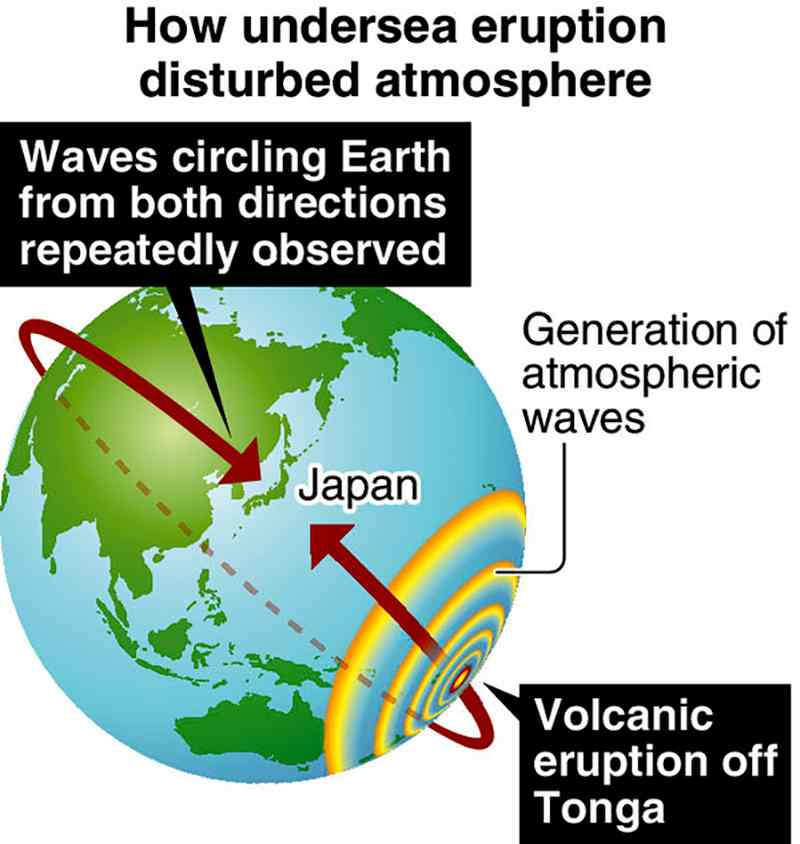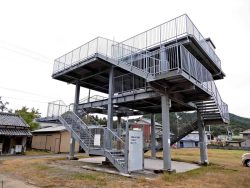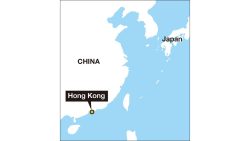
16:20 JST, January 24, 2022
The Jan. 15 eruption of an undersea volcano off Tonga marked the first time since modernized observation began in the 1980s that peculiar atmospheric waves were observed from a volcanic eruption, according to researchers at the Earthquake Research Institute of the University of Tokyo.
Atmospheric waves are a type of strong air vibration that circles the Earth.
The ones observed this time are called Lamb waves, which may have increased the atmospheric pressure and generated tsunami.
The Lamb waves are thought to have been generated by the expansion of the air around the volcano due to the heat of the massive eruption.
These waves travel at about 310 meters per second (1,116 kph), a little slower than the speed of sound, and are characterized by the fact that they are hardly attenuated and can reach a long distance.
These waves, which can arise from large-scale eruptions, are believed to have occurred during the 1883 eruption of Krakatau in Indonesia.
Circling Earth in a day
After the Tonga eruption, Associate Prof. Kiwamu Nishida of the institute analyzed data from microbarometers at about 500 locations around the world and found that Lamb waves were circling the Earth. The waves spread out in concentric circles from the volcano in the South Pacific, circling the Earth in about a day and a half, and were repeatedly observed, including those that came from the opposite direction.
The eruption took place at around 1 p.m. Japan time on Jan.15. The atmospheric pressure was observed to have increased by about 2 hectopascals around Japan from 7 to 9 p.m. the same day. The rise in pressure is believed to have been caused by the passage of the Lamb waves, and the rise in tide levels began to be observed in many places around this time.
It is believed that the Lamb waves pushed the sea surface, creating small waves as it moved, and that these waves accumulated near Japan to generate tsunami. Tsunami were observed in Japan about 2½ hours earlier than the Japan Meteorological Agency’s expected arrival time. Tsunami became even higher after 11:30 p.m.
“It is likely that tsunami caused by atmospheric waves, including Lamb waves, reached Japan first,” said Kenji Satake, director of the institute. “Then tsunami caused by changes in the seafloor topography seem to have arrived and overlapped.”
"Science & Nature" POPULAR ARTICLE
-

Genome Study Reveals Milestone in History of Cat Domestication
-

Big Leap in Quest to Get to Bottom of Climate Ice Mystery
-

Security Camera Footage Vulnerable to Outside Access; Investigation Finds 3,000 Pieces Exposed Online
-

Japan Set to Participate in EU’s R&D Framework, Aims to Boost Cooperation in Tech, Energy
-

Paws on Parade: Nairobi’s Dogs Dazzle at ‘Pawchella’
JN ACCESS RANKING
-

Tokyo Economic Security Forum to Hold Inaugural Meeting Amid Tense Global Environment
-

Keidanren Chairman Yoshinobu Tsutsui Visits Kashiwazaki-Kariwa Nuclear Power Plant; Inspects New Emergency Safety System
-

Imports of Rare Earths from China Facing Delays, May Be Caused by Deterioration of Japan-China Relations
-

University of Tokyo Professor Discusses Japanese Economic Security in Interview Ahead of Forum
-

Japan Pulls out of Vietnam Nuclear Project, Complicating Hanoi’s Power Plans






















